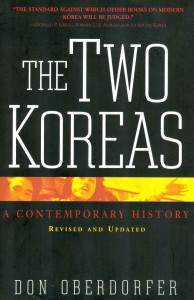 Veteran journalist and Korea-watcher Don Oberdorfer’s revised edition of his classic The Two Koreas: a Contemporary History (2002, ISBN 0-465-05162-6) remains an essential text on 20th century Korean history. Revised shortly after Kim Jong Il took power, the book traces the histories of North and South Korea, focusing on the Korean War and post-war years. Kim Jong Il’s third son, Kim Jong-un, now heads the North Korean (Democratic Peoples’ Republic of Korea, or DPRK), and Kim Dae Jung who was the president of South Korea (Republic of Korea, or ROK) when the book was revised, has been dead since 2009.
Veteran journalist and Korea-watcher Don Oberdorfer’s revised edition of his classic The Two Koreas: a Contemporary History (2002, ISBN 0-465-05162-6) remains an essential text on 20th century Korean history. Revised shortly after Kim Jong Il took power, the book traces the histories of North and South Korea, focusing on the Korean War and post-war years. Kim Jong Il’s third son, Kim Jong-un, now heads the North Korean (Democratic Peoples’ Republic of Korea, or DPRK), and Kim Dae Jung who was the president of South Korea (Republic of Korea, or ROK) when the book was revised, has been dead since 2009.
Although a decade has passed since its last revision, the underlying philosophies of North and South that are described in the book still have some degree of currency. At 445 pages of text, the book is exhaustive, much of it surrounding the endless push-pull of diplomatic attempts to stave of skirmishes and wars, with the goal of peaceful co-existence. The end-game, as established by the author, has been an underlying desire by both sides to reunite the country, while allowing each side to retain its political philosophy. In addition to the two Koreas, major players in this book are the United States, China, Russia, and Japan. The U.S., in particular, was heavily involved in talks with North Korea during the nuclear crisis, treading a thin line between North Korean brinkmanship and the South Korean desire to save face.
What emerges for the reader is a greater understanding of the North Korean position as well as an appreciation for the intricacies of negotiation in a Korean environment. Over and over again, throughout history, agreements are stalled or killed by real or perceived cultural slights. At other times rapprochement is damaged at inopportune times by North Korean incursions into South Korea (for example, the grounding of a North Korean submarine on North Korean shores in autumn, 2006). As the writer suggests, whether North Korean leadership knew of this mission or whether it had been approved by military factions wishing to subvert the peace talks will probably remain a mystery.
Oberdorfer’s a good writer, and the book begins reading like a novel, where the reader becomes involved in each Korea’s quest to live in harmony with the other. There are some fascinating behind-the scenes looks into North Korea, and Oberdorfer relies heavily on U.S. government documents and press reports to underscore the historical data. The book remains an essential one to anyone wishing to understand North Korea in particular, and the Korean dynamic in general. Buy it now at the WoWasis eStore.
Leave a Reply